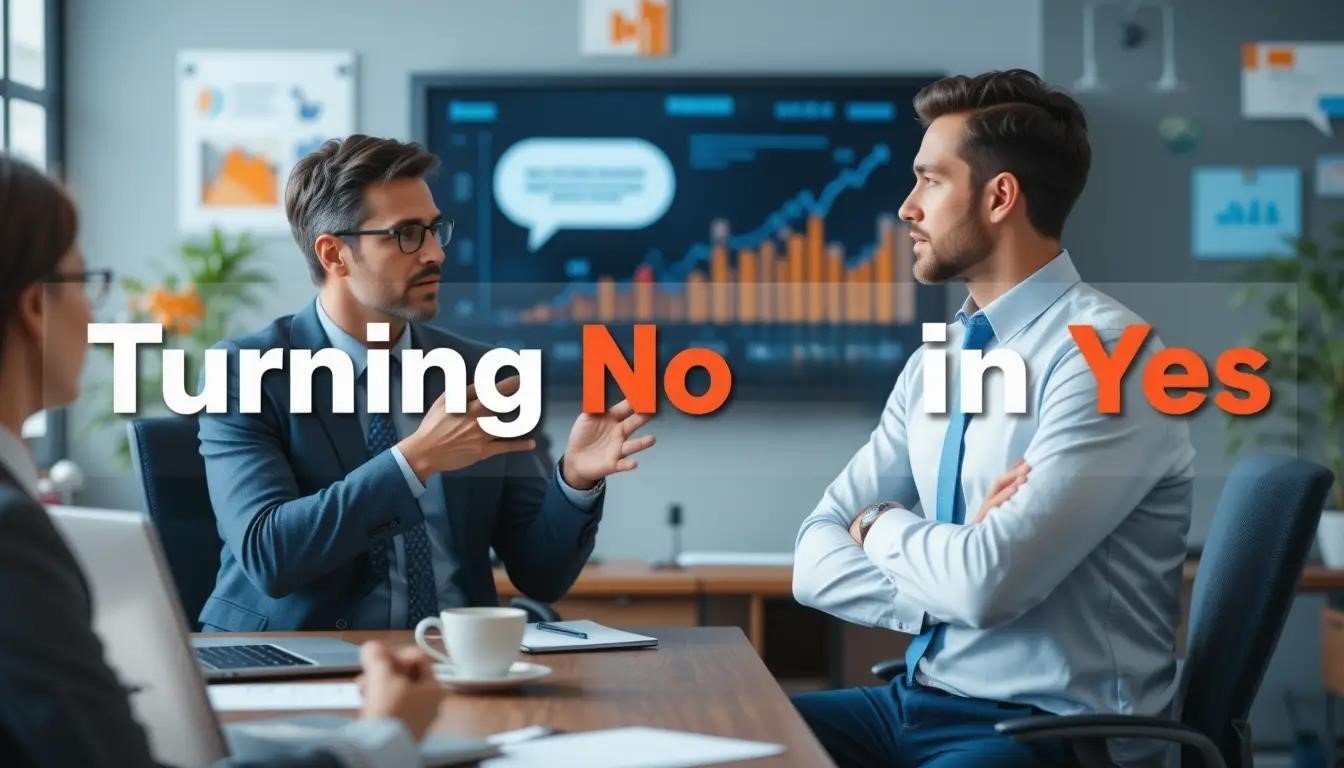Now Reading: Persuasive Sales Language: Turn Objections to Opportunities
-
01
Persuasive Sales Language: Turn Objections to Opportunities

Persuasive Sales Language: Turn Objections to Opportunities
Introduction
Objections are the heartbeat of sales conversations—every “no” or “maybe later” is a pulse signaling a prospect’s hesitation. For seasoned salespeople, these aren’t dead ends but openings to demonstrate value and build trust. With over 25 years in sales, marketing, and business development, I’ve learned that persuasive sales language isn’t just a skill—it’s an art form that turns skepticism into commitment. Whether it’s a price objection, a timing concern, or a lack of trust, the right words can shift the narrative from resistance to opportunity.
Research backs this up: 74% of buyers hesitate due to perceived risk, not outright rejection [1]. Your job? Use language to bridge that gap. This article dives deep into proven techniques, psychological principles, and real-world applications to help you master objection handling. By the end, you’ll have a robust toolkit to transform doubts into deals, grounded in data and practical experience.
The Power of Persuasive Sales Language
Understanding Objections: Why They Happen
Objections aren’t personal—they’re rooted in human nature. A Gong.io study found that 35% of objections center on price, 20% on timing, and 15% on skepticism about results [1]. These stem from three core fears: financial loss, wasted time, or unmet expectations. Prospects don’t reject your product—they’re testing its worth. Recognizing this shifts your mindset from defensiveness to curiosity, setting the stage for persuasion.
Consider this: a client says, “It’s too expensive.” They’re not saying “no”—they’re asking, “Is this worth it?” Your response can either reinforce their doubt or spark confidence. That’s where persuasive language comes in—it’s about listening, interpreting, and guiding.
The Psychology Behind Persuasion
Dr. Robert Cialdini’s Influence: The Psychology of Persuasion outlines six principles that drive decision-making: reciprocity, commitment, social proof, liking, authority, and scarcity [2]. In sales, these translate into actionable tactics. Offering a free trial taps reciprocity—people feel compelled to give back when given something first. Highlighting a client’s success leverages social proof, while a limited-time offer triggers scarcity. These principles, paired with empathetic language, turn objections into dialogues.
For example, when a prospect says, “I’ve tried this before,” citing a peer’s success (social proof) and your expertise (authority) can flip their perspective. Neuroscience supports this: storytelling and trust-based language activate the brain’s oxytocin release, boosting connection by 22% [8].
Why Language Matters
Words aren’t just sounds—they shape outcomes. HubSpot’s 2023 survey revealed that 69% of buyers favor salespeople who use clear, benefit-driven language over generic pitches [3]. Pushy tactics like “You need this now!” repel, while phrases like “Here’s how this solves your challenge” attract. Precision matters—vague responses lose trust, while specific, confident ones close deals.
Think of language as your sales currency. Spend it wisely, and you’ll earn a prospect’s investment.
Core Techniques to Turn Objections into Opportunities
1. Reframe the Objection as a Question
Scenario: “It’s too expensive.”
Response: “It sounds like you’re wondering if the value matches the cost. What specific goals are you aiming for, and how can we align this to meet them?”
Reframing flips a negative into a positive. The Journal of Marketing found that reps who rephrase objections as questions boost close rates by 20% [4]. Why? It invites collaboration, not confrontation. When a prospect feels heard, they’re more open to your solution.
How to Do It: Start with “It seems like” or “You’re asking,” then pivot to their needs. If they say, “It’s not the right time,” try, “It seems timing’s a concern—what would make it ideal?” This uncovers hidden priorities—like budget cycles or competing projects—letting you tailor your pitch.
Real-World Example: I once had a client balk at a $10,000 software fee. By asking, “What ROI are you targeting?” I learned they needed a 3x return. Showing how the tool saved $30,000 annually sealed the deal.
2. Leverage Social Proof
Scenario: “Does it really work?”
Response: “Great question—I’d wonder that too. Take [Client X], a mid-sized firm like yours. They cut onboarding time by 30% using this. What results are you hoping to see?”
People trust peers over promises. Salesforce data shows 92% of B2B buyers rely on testimonials to decide [5]. Specifics—like “30%” or “$50,000 saved”—add weight. Vague claims like “It’s great” fall flat; numbers and names stick.
How to Do It: Build a library of case studies. If selling CRM software, say, “A retailer with 50 stores boosted sales 15% last quarter with this.” Tie it to the prospect’s industry or size for relevance.
Pro Tip: Video testimonials amplify impact—buyers are 64% more likely to trust visual proof [13].
3. Highlight Unique Value
Scenario: “I’ve tried similar products before.”
Response: “I hear you—what’s different here is [unique feature], built to [specific benefit]. How does that compare to what you’ve used?”
Differentiation cuts through the noise. Bain & Company reports that 80% of customers switch due to unmet needs, not cost [6]. Your USP (Unique Selling Proposition) is your edge—know it, own it, sell it.
How to Do It: Map your product’s features to the prospect’s pain points. If they’ve used competitors, ask, “What didn’t work?” Then position your solution as the fix. For instance, “Unlike [Competitor X], our tool integrates with [specific software], saving you hours.”
Example: Selling a marketing platform? “Our AI-driven analytics predict trends—others just report them. How would forecasting help your campaigns?”
4. Offer a Guarantee
Scenario: “What if it doesn’t work?”
Response: “Totally valid concern. That’s why we back this with a 30-day money-back guarantee. You can test it risk-free—what do you think?”
Risk reversal is a game-changer. Harvard Business Review found guarantees lift purchase intent by 25% [7]. It’s a trust signal saying, “We stand behind this.” Even better, it shifts focus from “what if” to “why not?”
How to Do It: Be specific—“30 days” beats “satisfaction guaranteed.” Pair it with a question to keep them engaged: “How would you measure success in that time?”
Case Study: A SaaS client hesitated on a $5,000 package. Offering a 60-day trial with full refund turned “maybe” into “yes”—they stayed after seeing results.
5. Build Trust Through Storytelling
Scenario: “I don’t trust you yet.”
Response: “I get that—trust takes time. When I started in sales, I doubted tools like this too. But helping [Client Y] cut costs by 20% showed me the difference. What would build confidence for you?”
Stories connect on a human level. Neuroscience research proves narratives boost trust by 22%, activating emotional centers [8]. A personal or client story makes you relatable, not robotic.
How to Do It: Keep it short and relevant. Share a struggle-to-success arc: “I faced [similar issue], tried [solution], and saw [result].” Then ask what they need to feel secure.
Example: “A startup I worked with doubted our service. After a pilot, they doubled leads in three months. What proof would help you?”
6. Create Urgency with Scarcity
Scenario: “I’ll think about it.”
Response: “No rush—but this discount ends Friday, and we’ve only got five slots left. What’s the biggest factor you’re weighing?”
Scarcity drives action. Cialdini notes that rarity increases perceived value by 15% [2]. But it must be real—fake urgency backfires. Pair it with a question to avoid sounding pushy.
How to Do It: Use deadlines or limits: “Offer ends 2025” or “Stock’s down to [number].” Then probe: “What’s holding you back?” This keeps it collaborative.
Stat: 60% of “think about it” delays hide other objections—dig deeper [10].
Overcoming Common Sales Objections
Price Concerns
The Reality: Price tops the objection list—35% of buyers cite it [1]. But it’s rarely the real issue; it’s about value perception.
Strategy: Shift to ROI. “It’s $5,000 upfront, but clients see $15,000 back in six months. What’s your breakeven goal?” Break it down: cost per day, savings over time.
Data Point: Value-focused pitches retain 68% more customers [9].
Example: A CFO balked at a $20,000 consulting fee. Showing a $60,000 efficiency gain in year one turned “too much” into “smart investment.”
Timing Hesitation
The Reality: “Not now” stalls 20% of deals [1]. Often, it’s a smokescreen for budget or priority issues.
Strategy: Probe gently. “What would make it the right time? Is it budget, bandwidth, or something else?” Align your solution to their timeline.
Insight: 60% of delays mask deeper concerns—uncover them [10].
Example: A prospect said, “Q3’s better.” Asking “What’s Q3’s focus?” revealed a revenue push—our tool fit perfectly.
Skepticism About Results
The Reality: 15% doubt efficacy [1]. Without proof, they won’t budge.
Strategy: Use hard data. “Clients in your space saw a 40% uplift—here’s the breakdown. What results matter most to you?”
Stat: Evidence-based pitches close 28% faster [11].
Example: Selling to a manufacturer? “A peer cut downtime by 25%—that’s 50 hours monthly. What’s your efficiency target?”
Crafting Your Persuasive Language Toolkit
Key Phrases to Master
- Empathy: “I hear you—that’s a solid concern.” Shows you’re listening.
- Curiosity: “Tell me more about what’s behind that.” Digs into root issues.
- Value: “This delivers [benefit] by [how].” Ties features to outcomes.
- Confidence: “Given your goals, this fits because…” Projects assurance.
Avoid These Pitfalls
- Defensiveness: “That’s not true” kills rapport—acknowledge, don’t argue.
- Overpromising: “It’ll fix everything” sets unreachable bars. Be realistic.
- Jargon: “Synergistic ROI optimization” confuses—65% of buyers hate it [3].
Practice Makes Perfect
Rehearse with a partner or record yourself. Focus on tone—calm, confident, not rushed. The Sales Management Association found practiced reps outperform by 33% [12]. Start with common objections, then tweak based on feedback.
Future Trends in Persuasive Sales
The sales landscape is shifting. Forrester predicts 75% of buyers will prefer digital-first interactions by 2025 [13]. Email pitches, video demos, and social media engagement demand concise, persuasive language. AI tools now analyze objection patterns, suggesting real-time responses—think “price objection detected, try ROI focus.” But tech won’t replace the human touch; 82% of buyers still value empathy over automation [5]. Blend both for a winning edge.
Conclusion
Objections are gifts—they reveal what matters to prospects. With persuasive sales language, you can turn “It’s too expensive” into “It’s worth it,” “Not now” into “Let’s start,” and “I don’t trust you” into “I believe in this.” Techniques like reframing, social proof, and storytelling, backed by data and practice, empower you to close more deals. Start applying these today—your next objection is your next opportunity.
Frequently Asked Questions
Q1. How do I handle price objections without discounting?
A. Focus on value, not cost-cutting. Ask, “What’s the cost of not addressing this issue?” Then show ROI: “Clients see a 3x return in six months—how does that fit your budget?” Highlight benefits like time saved or revenue gained. Discounting trains buyers to wait for deals, eroding margins. Reserve it as a last resort after proving worth.
Q2. What if a prospect keeps delaying?
A. Delays often hide bigger issues. Ask, “What’s the biggest hurdle to moving forward—timing, budget, or priorities?” If it’s timing, tie your solution to their goals: “If Q2’s about growth, this boosts revenue 20%.” Be patient but persistent—60% of ‘not now’ objections mask something solvable with the right angle.
Q3. How do I build trust quickly?
A. Share a relatable story or success: “A client like you hesitated but saw 15% growth in three months.” Be transparent—admit limits if asked. Ask, “What would make you feel secure?” Quick trust comes from authenticity and listening, not slick pitches. A warm tone and specific examples accelerate connection.
Q4. Can urgency feel pushy?
A. Yes, if it’s forced. Use real scarcity: “This rate ends Friday—only three units left.” Avoid over-the-top pressure like “Buy now or lose out!” Balance with empathy: “I don’t want you to miss this—what’s your next step?” Genuine urgency motivates; pushiness alienates. Test your delivery for tone.
Q5. What’s the best way to practice persuasive language?
A. Role-play with a colleague using top objections—price, timing, trust. Record yourself to catch filler words or hesitations. Aim for calm confidence, not speed. Review with a mentor or team for feedback. Regular practice (weekly, 30 minutes) builds muscle memory—studies show it lifts performance 33%. Start today.
References
[1] – Gong.io | Sales Objection Trends Report – https://www.gong.io/resources
[2] – Cialdini, R. | Influence: The Psychology of Persuasion – https://www.influenceatwork.com/book
[3] – HubSpot | 2023 Buyer Behavior Survey – https://www.hubspot.com/research/buyer-behavior
[4] – Journal of Marketing | Reframing in Sales – https://www.jstor.org/journal/jmarketing
[5] – Salesforce | B2B Buyer Insights 2024 – https://www.salesforce.com/resources/b2b-insights
[6] – Bain & Company | Customer Retention Study – https://www.bain.com/insights/customer-retention
[7] – Harvard Business Review | Risk Reversal Impact – https://hbr.org/topic/sales
[8] – Zak, P. | The Neuroscience of Trust – https://www.pauljzak.com/research
[9] – McKinsey | Value-Based Selling Report – https://www.mckinsey.com/business-functions/marketing-and-sales
[10] – RAIN Group | Sales Delay Analysis – https://www.raingroup.com/resources
[11] – CSO Insights | Evidence in Sales Performance – https://www.csoinsights.com/publications
[12] – Sales Management Association | Training Efficacy Study – https://www.salesmanagement.org/research
[13] – Forrester | 2024 Digital Sales Trends – https://www.forrester.com/report/digital-sales-trends












